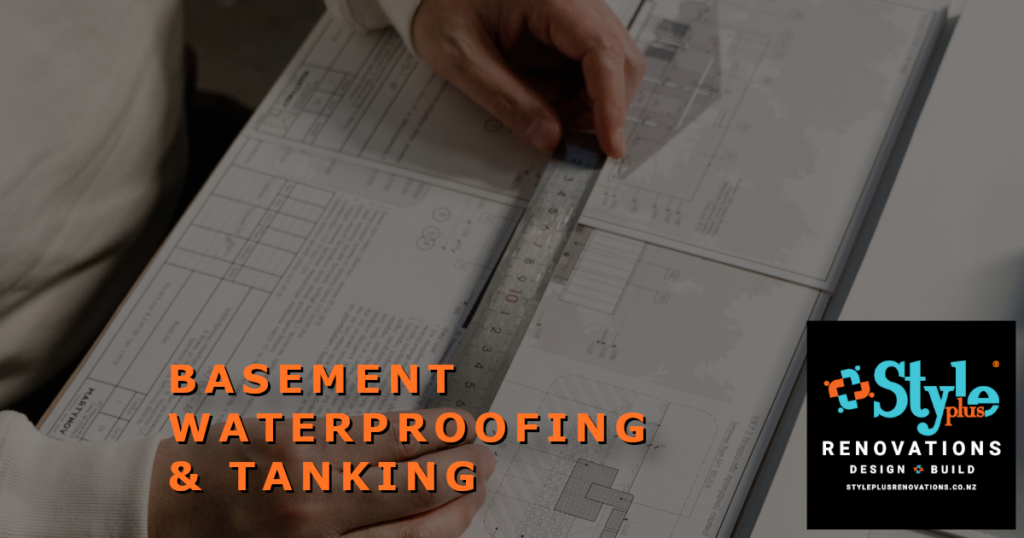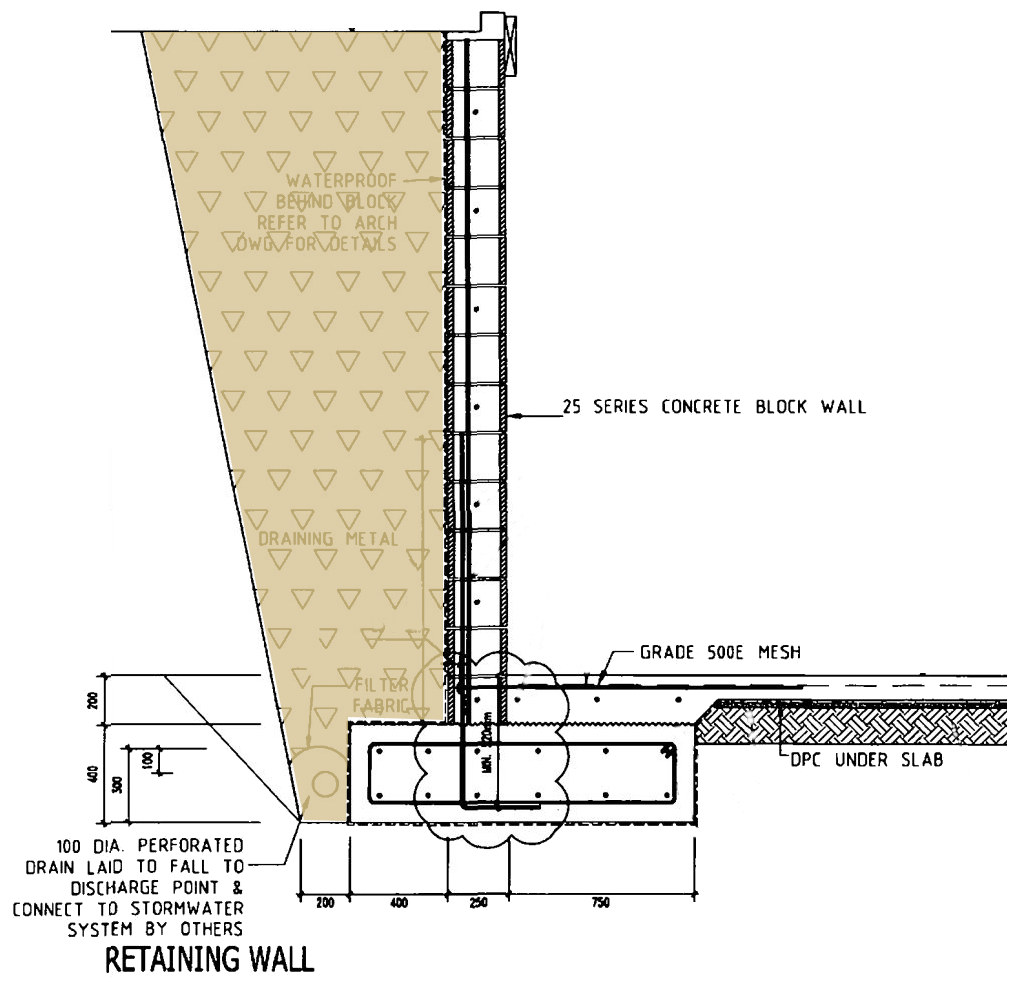BASEMENT WATERPROOFING
Are you planning a basement conversion or basement renovation and would like to know more about basement waterproofing and tanking options?
The team at Style Plus Renovations North Shore Auckland take a look at tanking and waterproofing options for a basement conversion.
- Basement conversion scenario.
- What constitutes a good basement waterproofing design?
- Tanking & waterproofing.
- Waterproofing types.
- Liquid paint-on membranes.
- Self-adhesive & torch-on.
- Basement conversion scenario – waterproof membranes.
- Drainage systems or cavity below-ground.
- Moisture through the concrete floor.
- Basement conversion scenario – rising moisture.
- Building code.
- Useful links.

BASEMENT CONVERSION SCENARIO – BASEMENT WATERPROOFING
A typical scenario is that you have a downstairs basement area such as an integral garage. The idea is to convert the garage into a habitable space.
The ground floor’s outer perimeter walls are concrete block walls. There is no lining on the walls, however, the ceiling has been lined.
Two sides of the outer perimeter walls are partially below ground level. There are signs of water ingress through the basement walls where the walls are partially below ground. Signs of efflorescence (a white powder residue) on the concrete surface. Also the general “damp” smell.
For this scenario, the focus of this article is on basement waterproofing i.e. the basement requires some form of waterproofing/tanking to prevent damp-related issues that could lead to more serious structural issues.
WHAT CONSTITUTES A GOOD BASEMENT WATERPROOFING DESIGN?
A good basement waterproofing design should include a system for removing excess water from the surrounding soil. Installing subsoil drainage, in which drainage pipes are installed underground to intercept and divert subsurface or seepage water, is an effective yet unobtrusive method.
A below-ground/subsoil drainage system should be installed around the perimeter of your home to drain water before it reaches the foundation.
A special geotextile-covered pipe is the most common type of subsoil drainage. The pipe has several perforations that allow water to drain away and enter. The geotextile covering prevents soil and other particles from entering and clogging the pipe. Granular backfill, drainage metal, which also acts as a free-draining system, is a simpler type of subsoil drainage. Typically, water from subsoil drainage is discharged into a cesspit.
BASEMENT TANKING & WATERPROOFING
Typically, a basement structure built on good, free-draining ground will stay dry. However, the issue is moisture or build-up of water in the ground surrounding the basement. Water penetrating the perimeter walls can result in mould growth and decay.
Two terms are associated with preventing water ingress these are waterproofing and tanking.
There is to some extent a misunderstanding about what exactly is tanking compared to waterproofing.
The term ‘tanking’ refers to below-ground waterproofing. This entails applying a waterproofing barrier/membrane to the external perimeter walls and concrete floor slab. The objective of waterproof tanking is to protect the below-ground space from water ingress by encasing the entire envelope.
On the other hand, waterproofing is a term used to describe multiple ways of weatherproofing and keeping water out of your home. This space could be above ground for example a bathroom, or the application of waterproofing liquid coating and tanking systems in a below-ground area.
Confused? Well, both serve the same purpose of preventing water ingress into a space you would like to stay dry, such as a basement.
BASEMENT WATERPROOFING TYPES
For our basement waterproofing scenario, we have two possible types of waterproof tanking:
- Waterproof Membranes are where there is a physical barrier placed outside of the below-ground structure to keep moisture from entering the space such as a basement.
- Drainage System, or cavity wall below-ground where water is allowed to enter the basement perimeter wall and then is pumped out. This type of system is relatively new to New Zealand.
WATERPROOF MEMBRANES BELOW-GROUND
Applying an external tanking membrane or liquid coating to the outside and/or inside of the perimeter wall to create a hydrophobic coating is the most common method of basement waterproofing.
Two types of below-ground waterproof membranes:
- Liquid paint-on membranes.
- Self-adhesive and torch-on membranes.
LIQUID PAINT-ON MEMBRANES
Types of liquid paint-on membranes:
- Bitumen, epoxies, polyurethanes and modified cement or bitumen.
SELF-ADHESIVE AND TORCH-ON MEMBRANES
Types of modified bitumen-based sheet coatings:
- Self-adhesive membrane.
- Torch-on membrane.
Self-adhesive or peel and sick are typically cold-applied self-adhesive membranes.
An example is Viking Peel & Stick Membrane. Viking Peel and Stick is a self-adhering waterproofing system consisting of a 1.5mm thick rubberised asphalt membrane, on the face of which a heavy-duty, high-impact polyethylene film, has been laminated.
The membrane is applied cold. The adhesive side has a removable release sheet that is peeled back at the time of application to a pre-primed substrate and then fully bonds to it.
The membrane must be protected against damage by the placement of protective material between the membrane and backfill.
A torch-on system typically consists of polyester and fibreglass-modified bitumen sheets in roll form. The membrane is torch applied.
An example is Viking’s Mercury FC Torch-on system. Viking Mercury FC comprises of 4mm thick polyester and fibreglass-modified bitumen membrane which is torch-applied to a compatibly primed surface. Being 4mm thick, it has high puncture resistance which is important for protection from damage during construction.
When installed on the external walls as a single layer, it can reach a depth of 3.5 metres, but when installed as a double layer, it can reach a depth of 10 metres below ground level.
Similar to the Peel & Stick, the torch-on membrane must be protected against damage by the placement of protective material between the membrane and backfill.
BASEMENT CONVERSION SCENARIO – WATERPROOF MEMBRANES
For our basement waterproofing scenario, any type of membrane (liquid or sheet) that needs to be applied to the external walls, below ground, would require the walls to be excavated so that they can be prepared for the application of the membrane.
The actual cost of the excavation is difficult to cost. It will likely be determined by the specifics of the project, location, soil type, access to where the excavation will take place and proximity to a tip site.
DRAINAGE SYSTEM OR CAVITY BELOW-GROUND
Drainage systems can be useful in situations where the application of an external waterproofing membrane is impractical. For example, the need to excavate the external perimeter wall to reveal the wall face that requires the external waterproofing membrane to be applied is problematic and is not an option.
- Drainage System or cavity system typically encompasses wall and floor waterproof membranes and includes PVC ducts and pipes that divert any water in a basement to a pump-drained sump.
An example of a drainage system is the Newton CDM System (Basement Water Management System). Water leaking through the structure is accepted into voids and air spaces created by cavity drain membranes placed inside the structure i.e. basement, depressurizing the incoming water and safely removing it from the property.
For our basement waterproofing scenario, the majority of work is carried out internally. However, there is drainage work to be carried out.
MOISTURE THROUGH THE CONCRETE FLOOR
The formation of damp patches/rising moisture on the surface of a concrete floor is an indication that it has moisture damage. Rising moisture not only compromises the structural integrity of the concrete floor but can also prevent protective coatings from adhering to it.
Rising moisture also causes the rotting/mould growth of wood, floor coverings, and furnishings, which can lead to health problems for the occupants. It can also cause odours and make the space more difficult to heat.
Rising moisture occurs when the ambient temperature rises, causing moisture to be drawn up from the ground and through the concrete.
For basement waterproofing, the installation of a Damp Proof Membrane (DPM) / Damp Proof Course (DPC) is mandatory under concrete floor slabs for all habitable spaces and under concrete floor slabs such as garages or ancillary buildings that may in the future be converted to habitable spaces. The DPM’s role is to prevent rising moisture from entering the concrete floor slab from the ground.
If it has been determined that the DPM has failed or was not installed before the floor was laid. A Liquid Epoxy DPM is typically used as a corrective measure.
The epoxy DPM is designed to deal with the constant low levels of moisture found in concrete floor slabs. It has strong adhesion properties that prevent it from lifting off the surface of the concrete floor slab.
The epoxy DPM is applied to the floor, forming an impermeable layer that keeps water in the concrete slab.

BASEMENT CONVERSION SCENARIO – RISING MOISTURE
For our basement waterproofing scenario, there are no signs of rising moisture.
However, as a cautionary measure, it would be wise to test the moisture content of the concrete floor and determine if there is a Damp Proof Membrane (DPM) between the concrete and the ground or if the DPM has failed.
If there is an issue with rising moisture there are two options available:
- Remove the old concrete floor slab, and install a new DPM. Then lay a new concrete floor slab.
- Fully isolate the rising moisture in the old concrete floor slab using a surface liquid epoxy DPM.
BUILDING CODE
Each waterproofing/tanking solution is completely customised to the clients and projects requirements; there is no one-size-fits-all solution.
Basement wall leaks beneath ground level can be extremely difficult to repair or locate. Waterproofing should not be overlooked in any renovation project because the cost, time, and hassle factor can be prohibitive if subsequent remedial work or membrane replacement is required.
A performance requirement of Building Code clause E2 External moisture is that walls, floors and structural elements close to or near the ground must not absorb or transmit moisture in quantities causing undue dampness and/or damage to building elements.
Also, the performance requirement of Building Code Clause B2 comes into play with 50-year durability for waterproofing, as it is difficult to access or replace once the building work is completed.
OTHER USEFUL LINKS
- Building Code Clause B2.
- Building Code Clause E2.
- Basement conversions – our services.
- Basement renovation costs.
Whilst all information is considered to be true and correct at the date of publication, changes in circumstances after the time of publication may impact on the accuracy of the information. The information may change without notice and Style Plus Ltd is not in any way liable for the accuracy of any information printed and stored or in any way interpreted and used by a user.
Get started with a Free
Architects Renovation Feasibility Report
LET'S START
YOUR RENOVATION PROJECT
Tel us about your renovation project and we’ll call you back for a no-obligation chat about your ideas.
Alternatively, if you prefer, we can initially set up a meeting using Microsoft Teams or Zoom (and other meeting apps) for a no-obligation chat about your ideas.
We look forward to hearing from you to discuss your project and get you started on your renovation journey.
If you would like to know more about our renovation process, check it out here.

